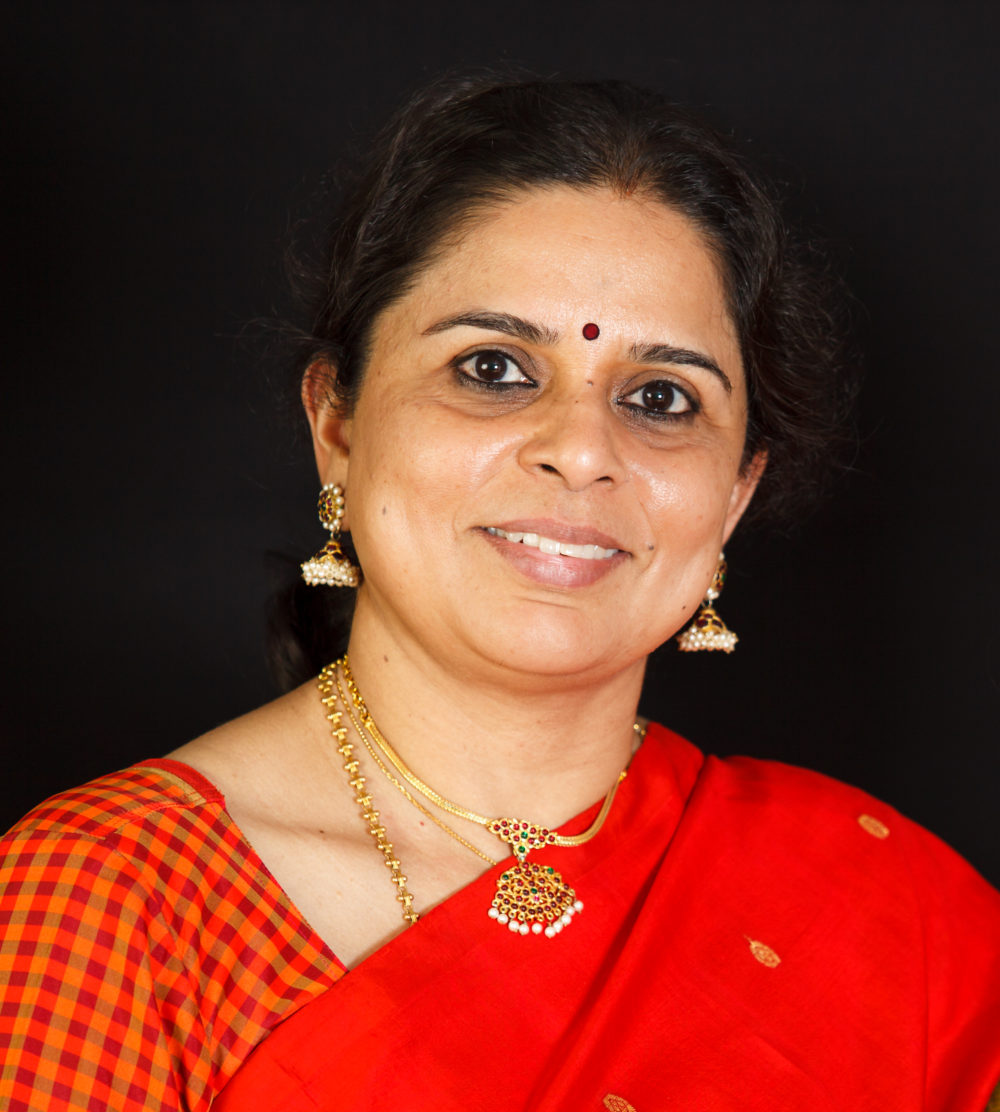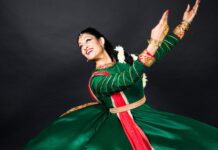By Pallavi Nagesha
Samkhya enumerates 25 principles that are the connections between the natural workings of the world and our experience as humans in it. After accounting for all the indriya, tanmātra, and the mahābhūta, we are left with Puruṣa, or pure consciousness. A substance beyond time and space. I though it very fitting for a school of dance to celebrate its 25th year of service examining art through the myriad of lenses that help peel away at human experiences to allow us a glimpse at that one efficient cause of all.
On September 1st, Natyanjali School of Dance celebrated their milestone with Natya Nostalgia at the Shirdi Sai Temple in Groton. An event that brought together the art, the story behind the art, the thought that goes into the art, and a glimpse into its inevitable evolution. The event was attended by many dance teachers of the area as well as many not of Indian origin. Notable among them were Massachusettes House Representative Jim Ariciero, Bernie Zubrowski from the Littleton Cultural Council, Russ and Dev from Groton and Margaret Smith from Westford.
 The celebrations began with Jeyanthi Ghatraju, the Guru, receiving commendations from the Massachusetts House of Representatives, presented by Jim Ariciero and the State Senate, presented by the community stalwarts, Sri K.G and Smt. Radha Narayana. Jeyanthi also had generous support of Massachusetts Cultural Council through local cultural councils of Acton-Boxborough, Groton, Littleton, and Westford.
The celebrations began with Jeyanthi Ghatraju, the Guru, receiving commendations from the Massachusetts House of Representatives, presented by Jim Ariciero and the State Senate, presented by the community stalwarts, Sri K.G and Smt. Radha Narayana. Jeyanthi also had generous support of Massachusetts Cultural Council through local cultural councils of Acton-Boxborough, Groton, Littleton, and Westford.
This was followed by an engaging presentation on Nāṭyaśāstra by Shekhar Shastri, a renowned scholar and artist. He examined the core of all performance. How does one generate the rasa, the aesthetic delight? A dancer, not unlike any other artist, strives to touch the hearts and souls of the spectators. Shekhar helped the young dancers of Natyanjali, other artists, and Sahṛdaya understand how one must drop their mundane selves in order to embody the idea being conveyed through their art. Every interaction between the artist and the connoisseur is a delicate dance between control and surrender. The pushing and the letting go that becomes an open-ended exploration of your being.
This was followed by lively segments that examines the many facets of dance. Suman Adisesh addressed rhythm that exists all around us. I find rhythm fascinating. It is not just beats in patterns but a pulsation that haunts and drives, and when handled with care can aid reverberation of the aesthetic delight. Sailaja Edupuganti and Dristi Neog explored the idea of symbiosis in the different forms of classical dance. Movement is the inquiry of the space between two breaths. As it takes shape, forms should dissolve and only that enquiry into pure delight should emerge. Neena Gulati, a senior and respected classical dance guru in the community, held her audience captive as she demonstrated that joy, either feeling or spreading of, has no expiry date. Many seniors and first-time dancers joined her in this storytelling excursion. Manasa Jayanthi, a young second generation teacher spoke about the place of Āhāryaṃ or physical adornment. Putting on a “face” is intrinsic to this idea and Jayanthi demonstrated the importance of a well made up face and the effect it has on the performance.
One unique component of the event was a thought-provoking panel discussion on teaching students with special needs. This discussion led by Meena Subramanyam brought to the fore many perceptions and points of view. It led me and other panelists to conclude that as art evolves so should those who teach art. Clinging to tradition, while a noble endeavor, restricts one’s ability to reach across aisles and embrace differences. Jaya Pandey, an avid champion of people with special needs, highlighted the difficulties parents face in enabling these special kids. Her questions to the teachers of what they would advise parents to do was simple, yet the most challenging to respond to. Art must enable us to shed all the labels and look beyond at the kernel of truth and joy. When we surround ourselves with fear, shame and prejudice, there is little space for anything else. A true guru is capable of unlearning in order to find new pathways to knowledge.
These sessions were followed by a dance recital of the students of Natyanjali. Students of varying ages and proficiencies exhibited their learning of Bharatanāṭyam, the classical dance form taught by Jeyanthi. The ensemble was accompanied by live music comprising of second generation classical Indian musician. While Jeyanthi herself played naṭṭuvaṅgaṃ, Hamsa Shanmugam leant her voice, Hari played the mṛdaṅgam, Naresh Vytheswaran accompanied with the flute, and Sai Srinidhi Datla was on the keyboard. Crisp choreography, practiced execution was replete with an inherent echo of guru Jeyanthi’s sāttvic nature.
I met Jeyanthi over 20 years ago and have had the pleasure to work with her professionally and build a deep personal connection. Her genuine nature and kindness shines through her work. One of my teachers often says that to be a good artist, you have to be a good human first. When you are kind, you look for and find positivity around you and that opens your entire being to these vibrations. As you absorb them, your inner eye can turn these experiences into an introspection of the great universe within and without. As you begin to melt into that greater whole, that aesthetic delight is sure to shine through. I commend Jeyanthi for giving this opportunity to her students and the rasikas of New England alike to explore these ideas of performance and delight. I am sure to see many more milestones for Natyanjali and for Jeyanthi personally and am delighted to share this incredible journey.
Pallavi Nagesha, the founding director of Bhūmikā Arts teaches Bharatanatyam, Sanskrit, Yoga, and the Ayurvedic lifestyle. Pallavi believes that Dance, Yoga and Āyurveda are three inseparable components that open you to new and transformative experiences.
















